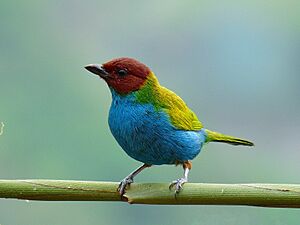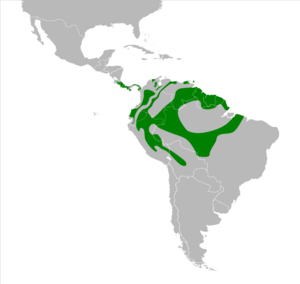Bay-headed tanager facts for kids
Quick facts for kids Bay-headed tanager |
|
|---|---|
 |
|
| In Colombia | |
| Conservation status | |
| Scientific classification | |
| Genus: |
Tangara
|
| Species: |
gyrola
|
 |
|
| Synonyms | |
|
|
The bay-headed tanager (Tangara gyrola) is a colorful, medium-sized bird. It is a type of passerine bird, which means it belongs to a large group of birds known as "perching birds."
These tanagers live in Costa Rica, Panama, and parts of South America. You can find them as far south as Ecuador, Bolivia, and north-western Brazil. They also live on the island of Trinidad.
Contents
About the Bay-Headed Tanager
Who Discovered This Bird?
The bay-headed tanager was first officially described by a Swedish scientist named Carl Linnaeus. He wrote about it in 1758 in his famous book, Systema Naturae. He gave it the scientific name Fringilla gyrola at that time.
Later, the bird was placed in the Tangara group. This group was named by a French zoologist, Mathurin Jacques Brisson, in 1760.
Different Kinds of Bay-Headed Tanagers
There are nine different types, or subspecies, of the bay-headed tanager. They are all slightly different depending on where they live:
- T. g. bangsi: Found from Nicaragua to western Panama.
- T. g. deleticia: Lives in eastern Panama to central and western Colombia.
- T. g. nupera: Found in southwestern Colombia, western Ecuador, and northwestern Peru.
- T. g. toddi: Lives in northern Colombia and northwestern and northern Venezuela.
- T. g. viridissima: Found in northeastern Venezuela and Trinidad.
- T. g. catharinae: Lives from central Colombia through eastern Ecuador and eastern Peru to western and central Bolivia.
- T. g. parva: Found in eastern Colombia, southern Venezuela, northeastern Peru, and northwestern Brazil.
- T. g. gyrola: Lives in southeastern Venezuela, the Guianas, and northern Brazil. This is the original type described by Linnaeus.
- T. g. albertinae: Found in central Brazil, south of the Amazon River.
What Does It Look Like?
Adult bay-headed tanagers are about 14 centimeters (5.5 inches) long. They weigh around 19.5 grams (0.7 ounces).
The most common type, T. g. gyrola, is mostly green. It has a bright chestnut-colored head. Its belly can be blue or green, and it has a thin gold band on the back of its neck.
Both male and female birds look similar. Young birds are usually duller in color. Their heads might be green with some chestnut spots. Some subspecies, like T. g. viridissima from Venezuela and Trinidad, have green bellies that match the rest of their body.
What Does It Sound Like?
The song of the bay-headed tanager is slow and sounds like seee, seee, seee, tsou, tsooy.
Where Does It Live?
Bay-headed tanagers live in forests. They especially like areas where it is wetter.
Nests and Eggs
These birds build a large, cup-shaped nest in a tree. A female tanager usually lays two white eggs. These eggs often have brown spots on them.
The female bird sits on the eggs for about 13 to 14 days until they hatch. After the chicks hatch, they stay in the nest for another 15 to 16 days before they are ready to fly.
How Does It Live?
Bay-headed tanagers are social birds. This means they often live and feed in groups.
What Do They Eat?
They mostly eat fruit, which they usually swallow whole. They also eat insects. They often find insects by looking on the underside of tree branches.


